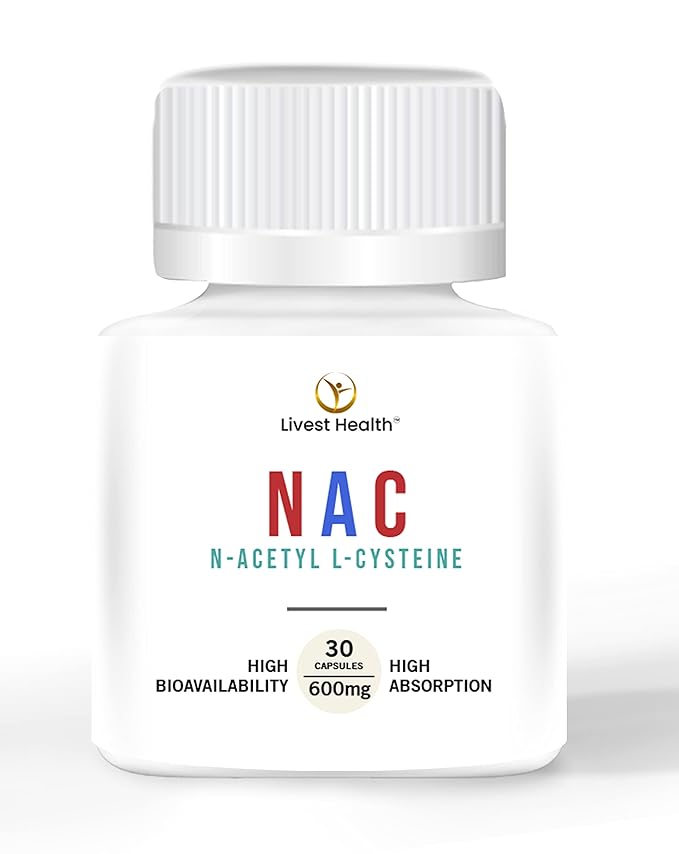N-acetyl l-cysteine, commonly known as NAC, has garnered attention in the medical community and among health enthusiasts for its diverse potential benefits. As a derivative of the amino acid cysteine, NAC has properties. This ranges from supporting lung health to acting as a lifesaving antidote in specific emergencies.
Let's delve deeper into this intriguing compound's multifaceted uses and benefits.

Mucolytic Agent
NAC is a potent antioxidant and a mucolytic agent. Within the respiratory system, mucus plays a vital role in trapping and clearing out potential pathogens and irritants. However, overly thick or excessive mucus can obstruct airways. This can make breathing difficult and lead to the growth of pathogens.
How Does NAC Work as a Mucolytic?
The human mucus is made up of glycoproteins. NAC serves as a mucolytic by breaking the disulfide bonds in those glycoproteins. This action results in a reduction of mucus viscosity, making it less thick and sticky. As the mucus becomes more watery, it can be more easily expelled through coughing, clearing the airways.
Applications in Respiratory Diseases
- Chronic Obstructive Pulmonary Disease (COPD): Patients with COPD often produce more mucus, exacerbating their symptoms. NAC can help alleviate some of these symptoms by making the mucus less tenacious, improving mucus clearance, and potentially reducing the frequency of COPD exacerbations.
- Asthma: Asthmatic patients can benefit from improved mucus clearance, which can help in reducing airway obstruction and improving airflow.
- Cystic Fibrosis: This genetic disorder produces thick, sticky mucus that can clog airways and lead to infections. NAC, by breaking down this mucus, can be an adjunct therapy to improve the respiratory condition of these patients.
- Bronchitis: Whether acute or chronic, bronchitis involves inflammation of the bronchi, often accompanied by mucus production. NAC can assist in making this mucus less viscous and easier to clear.
Paracetamol (Acetaminophen) Overdose
Paracetamol (known as acetaminophen in the U.S. and some other countries) is an over-the-counter and antipyretic pain reliever. However, its intentional or accidental overdose can be life-threatening, primarily due to its toxic effects on the liver. NAC has emerged as a crucial antidote in treating paracetamol overdose, and understanding its role is vital for medical professionals and the general public.
Mechanism of Toxicity in Paracetamol Overdose
The liver safely metabolizes and excretes paracetamol in therapeutic doses. However, in cases of overdose, the liver's standard metabolic pathways become saturated, accumulating a toxic metabolite called N-acetyl-p-benzoquinone imine (NAPQI). NAPQI can cause severe liver cell damage by binding to cellular proteins, leading to oxidative stress and hepatocyte death.
Under normal circumstances, the liver detoxifies NAPQI using glutathione, a powerful antioxidant. But when overdosed, the liver rapidly depletes its glutathione reserves, leaving NAPQI unchecked, which leads to extensive liver damage.
How Does NAC Help?
- Glutathione Precursor: NAC is a precursor to glutathione. When administered after a paracetamol overdose, it boosts the body's glutathione levels, allowing the liver to detoxify NAPQI more effectively, preventing or reducing the extent of liver damage.
- Direct Binding: Apart from its role in glutathione synthesis, NAC can directly bind to NAPQI, neutralizing its harmful effects and safeguarding the liver from injury.
- Enhancing Sulfation: NAC can also promote the sulfation pathway, one of the liver's primary mechanisms for paracetamol metabolism, especially when the primary pathways become saturated.
Administration and Timing
Quick intervention is critical. The effectiveness of NAC is highest when administered within 8-10 hours of the overdose. NAC can be given orally or intravenously. The intravenous route is often preferred in severe cases due to its rapid onset of action.
Antioxidant Support
NAC is an amino acid derivative studied extensively for its antioxidant properties. Beyond its recognized role in detoxifying paracetamol (acetaminophen) overdoses, NAC plays a pivotal part in cellular defense mechanisms against oxidative stress, a common culprit in various pathological conditions and aging processes.
Understanding Oxidative Stress
At the cellular level, the body continuously produces reactive oxygen species (ROS) as a byproduct of various metabolic processes. While ROS have important roles in signaling and homeostasis, excessive amounts can damage cellular components, including proteins, lipids, and DNA. This imbalance between ROS production and the body's ability to detoxify or repair the resulting damage is termed oxidative stress.
Mechanism of Action of NAC in Antioxidant Support
- Glutathione Synthesis: NAC's most prominent role in antioxidant defense is as a precursor to glutathione, one of the body's primary antioxidants. Glutathione neutralizes ROS, safeguarding cells from oxidative damage. By providing cysteine, which is often the rate-limiting amino acid in glutathione synthesis, NAC helps boost cellular glutathione levels.
- Direct Scavenging: Besides its indirect action through glutathione, NAC can directly scavenge certain reactive oxygen species, thus neutralizing them.
- Restoration of Oxidized Vitamins: NAC can also aid in restoring other antioxidants like vitamins C and E to their active forms after they've neutralized ROS and become oxidized.
Clinical Implications
NAC's antioxidant properties have made it an area of interest in various clinical scenarios:
- Chronic Respiratory Conditions: NAC has been explored as a treatment in chronic obstructive pulmonary disease (COPD) and asthma, not only for its mucolytic properties but also for its potential to reduce lung oxidative damage.
- Neurodegenerative Diseases: Oxidative stress has been implicated in disorders like Alzheimer's, Parkinson's, and multiple sclerosis. Research is ongoing to determine NAC's potential in mitigating the progression of such diseases.
- Cardiovascular Health: Oxidative stress can contribute to endothelial dysfunction and atherosclerosis. NAC might offer cardiovascular protection by reducing oxidative damage in the heart and blood vessels.
- Fertility: Oxidative stress can impair male and female fertility. Studies suggest that NAC might improve reproductive health by reducing oxidative damage in reproductive tissues.
Psychiatric and Neurological Conditions
Some studies suggest that NAC may have potential benefits in various neurological and psychiatric disorders, including depression, bipolar disorder, schizophrenia, and obsessive-compulsive disorder (OCD), due to its antioxidative and anti-inflammatory properties. However, more research is needed in this area.
Substance Abuse Treatment
Preliminary research indicates that NAC might help reduce the cravings and addictive behaviors associated with some substances, like cocaine and nicotine. Again, more studies are needed to establish its efficacy in this context.
Other Potential Benefits
NAC has been studied for a range of other potential applications, including supporting fertility in women with polycystic ovary syndrome (PCOS), reducing symptoms of respiratory conditions, and potentially aiding in conditions like Alzheimer's disease, although research in these areas is still ongoing.

References
- https://www.ncbi.nlm.nih.gov/pmc/articles/PMC2707813/
- https://www.ncbi.nlm.nih.gov/pmc/articles/PMC8234027/
- https://pubmed.ncbi.nlm.nih.gov/10090545/
- https://www.ncbi.nlm.nih.gov/pmc/articles/PMC9487680/
- https://www.ncbi.nlm.nih.gov/pmc/articles/PMC5241507/
- https://www.ncbi.nlm.nih.gov/pmc/articles/PMC4110842/





